Gucci Symbols 101: Logos, Main Motifs and Buckles
by Charlotte Banfield on Dec 11, 2021
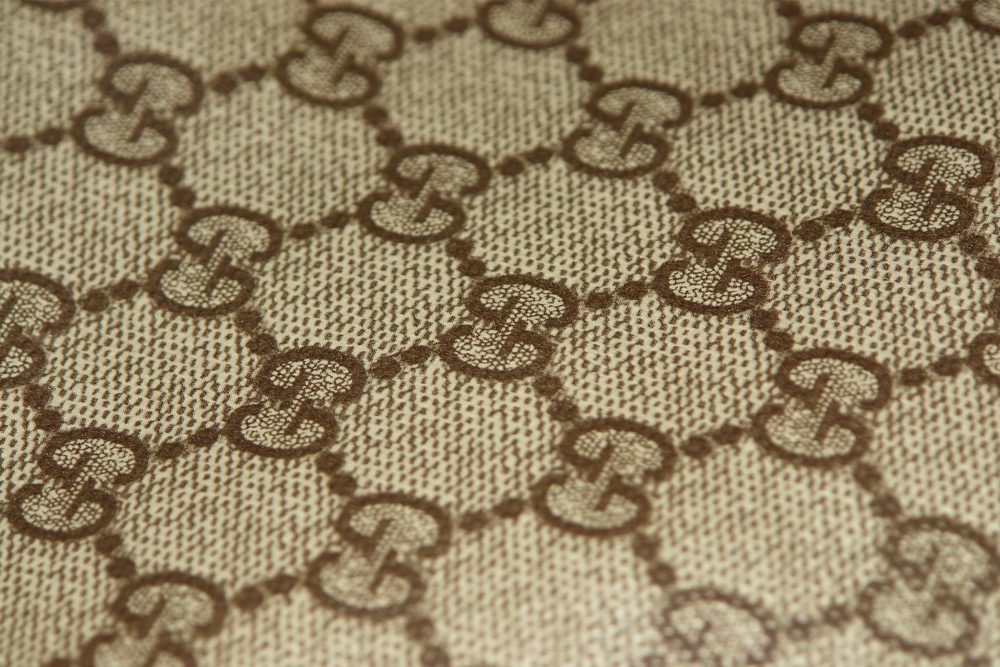
Gucci is as iconic as it is inescapable: whether you’re walking down the street, flipping open a magazine, or scrolling through your Explore page on Instagram, you can see Gucci (and wannabe Gucci) belts, shoes and bags everywhere. But what makes Gucci products stand out so much? How can one brand be so instantly recognisable, even when in the midst of a sea of luxury brands?
The answer is simple: logomania.
Now, I’m not saying that other brands don’t realise the power of logos, far from it. Chanel has their iconic interlocking Cs, Louis Vuitton’s monograms can be seen from miles away, and Goyard’s chevron is hard to miss — assuming you know what to look for. Yet Gucci embraces symbols, logos and motifs in a way that no other brand has done, and thus has created a world where you can see two products with absolutely zero similarities but still know that they’re both made by Gucci.
Main Gucci Logo:
The iconic GG logo that we know and love today was created in the 1930s by Aldo Gucci, the son of Gucci’s founder Guccio Gucci. The two Gs face each other and are interlocked, resembling a chain link. Not only does this evoke a sense of endurance and tenacity, it also helps represent the brand’s devotion to luxury through the logo’s similarity to bracelet links. When Guccio passed away in the 1950s, Aldo briefly changed the GG logo to an emblem of a knight standing within a shield.
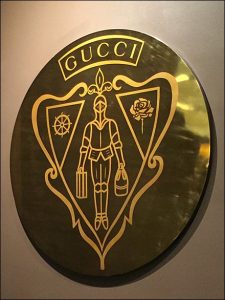
The Gucci logo was later edited for their monogram print in the 1960s, the interlocking Gs being replaced by one right-side-up G and one upside-down one. This new version of the Gucci logo proved to be a smash success, and the monogram canvas is still one of the most popular materials for Gucci bags to this day (and also the most copied).

As new creative directors joined the brand, the Gucci logo continued to evolve. In 1990, Tom Ford reimagined the Gucci logo, changing the font from bold serif letters to a more cubic style. Alessandro Michele, the current creative director, further reinterpreted the logo by creating the Marmont style —more on that later. Interestingly, despite the logo’s prominence in the fashion industry, the Gucci emblem isn’t trademarked in the UK, due to them forgetting to renew their trademark license on time in 2012, and losing the subsequent court case that followed.
The Gucci Bee:
Gucci’s collections over the past six years have been a source of whimsy in fashion, featuring various members of the animal kingdom from embroidered tigers on Gucci monogram canvas to embellished bees on shoes and bags alike. Alessandro Michele is the force behind this movement, stating that he has a fascination with “nature’s physical and spiritual beauty”.
First created as an emblem for the house of Gucci in the 1970s, Michele chose to highlight the bee in his Fall-Winter collection in 2015. Bees were a symbol of nobility in Europe, and as such hold connotations of luxury and aristocracy, qualities that are synonymous with the Gucci brand. The Gucci bees can be embroidered — such as the Gucci bee suit worn by Eddie Redmayne at the 2016 Golden Globes — but are more often embellished with Swarovski crystals and faux-pearl detailing.
Here are some products we have at The Hula that feature the Gucci bee:
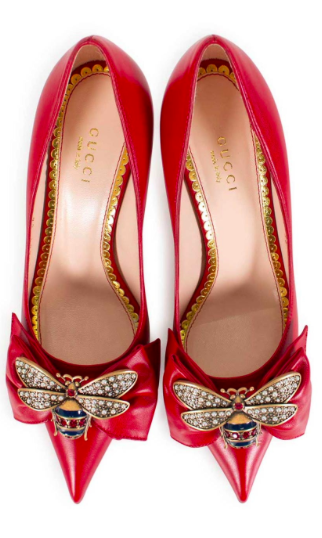
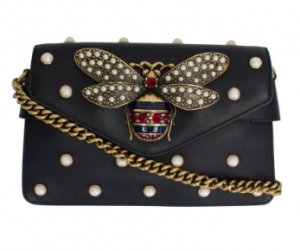
(Bag: sold / Shoes: sold)
OTHER ANIMAL SYMBOLS:
Other popular animal symbols in Gucci’s collections include snakes and tigers. There is a rich history of symbolism attached with both animals, snakes having represented the qualities of seduction and power since Biblical times. Tigers, on the other hand, have been heavily referenced in Asian cultures throughout history, especially in China. Not only are tigers the embodiment of “yang” (luck), they also symbolise power, energy, royalty and wealth, having long been associated with the Chinese god of wealth, yellow tigers in particular seen as the “supreme ruler” of all tigers. As Gucci has grown in popularity in Asia over the years, with Chinese consumers conducting 40% of the world’s spending on luxury goods , it is no surprise that Michele would take inspiration from these cultures to create new symbols and appeal to these emerging markets.
[caption id="attachment_14955" align="aligncenter" width="375"]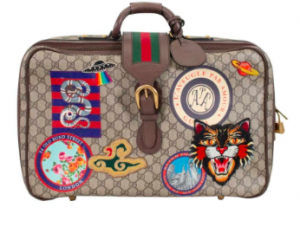 Supreme GG Logo Patterned Hand Luggage with Gucci Motifs Patches. Shop it now.[/caption]
Supreme GG Logo Patterned Hand Luggage with Gucci Motifs Patches. Shop it now.[/caption]
THE DIONYSUS BUCKLE:
The original Dionysus bag was released in Gucci’s Fall-Winter collection in 2015, and has grown to become one of the most popular bag styles in Gucci history. The Dionysus bag’s iconic buckle features metal hardware in the shape of a horseshoe — taking influence from Guccio Gucci’s fascination with equestrianism — with tiger heads on the tip of the hardware.

The Dionysus bag was named after the Greek god of wine and revelry, and thus evokes an air of indulgence. Michele’s fascination with the god can also be seen in his 2016 Cruise collection, which he named “The Dionysus Dance”. This campaign contained a combination of new elements and references to the 70s and 80s, with brilliant colours and textures being utilised. Alessandro Michele states that this collection has “a romanticism that is more nuanced, subtle and multidimensional”, breaking away from “palpable sexuality” to embrace the fantastical.
[caption id="attachment_14961" align="aligncenter" width="356"]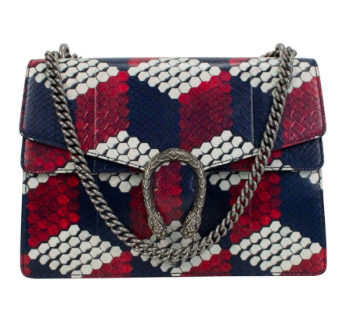 Gucci Dionysus Nag in Multi-colour-way with Sliver Brass Hardware. Shop it here.[/caption]
Gucci Dionysus Nag in Multi-colour-way with Sliver Brass Hardware. Shop it here.[/caption]
Gucci Marmont:
The Gucci Marmont was established in 2016 as Michele’s reinvention of the 70s Gucci logo. Rather than having the two Gs face each other, like in the original GG logo, the Marmont logo has both Gs facing the same direction, coming in classic gold, silver, textured gold or with pearl embellishments.
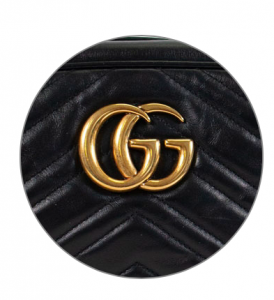
This new interpretation of the Gucci logo proved to be exceedingly popular with customers: the black Gucci Marmont belt was the third most-shopped designer item in 2017 (The Gucci Blooms slides came first and the Balenciaga sock sneaker was the runner-up). Gucci Marmont bags are also one of the most popular bags made by Gucci, and come in a wide variety of materials and textures, such as denim, grained leather, matelasse, and the ever-popular zigzag quilting.
[caption id="attachment_14963" align="aligncenter" width="412"]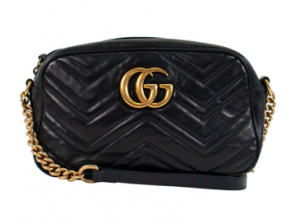 Gucci GG Marmont Black Quilted Leather Camera Bag with Golden Brass Hardwarde.[/caption]
Gucci GG Marmont Black Quilted Leather Camera Bag with Golden Brass Hardwarde.[/caption]
(Bag: Sold)
Gucci Horsebit:
The Gucci Horsebit is one of the most iconic features in Gucci products, from loafers to handbags. The Horsebit consists of a double ring and a bar, both in metal.

Established in the 1950s, the Horsebit became part of the Gucci emblem family after Guccio Gucci’s stint at the Savoy in London, where he gained inspiration through the British equestrian set. The Horsebit began appearing on loafers in the 1950s, and moved on to feature on handbags as well in 1955. Nowadays, the Gucci Horsebit is an iconic staple of the brand, Michele recently relaunching the Horsebit bags with a collection of top handle bags, bucket bags and totes named the 1955 Horsebit.
[caption id="attachment_14972" align="aligncenter" width="312"]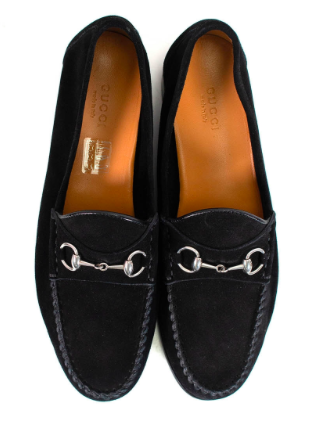 Gucci Horsebit Loafers in Black Suede. Shop it here.[/caption]
Gucci Horsebit Loafers in Black Suede. Shop it here.[/caption]
Gucci Piston Lock:
Originally seen on the Jackie bag — formerly known as the Fifties Constance bag — the piston lock was created in 1961.
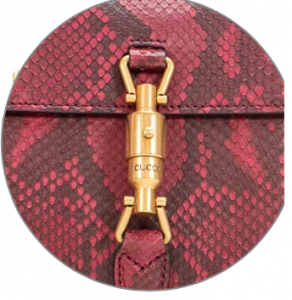
Since then, the lock on the Jackie has been modified and reinvented into a sleeker, more updated lock. The piston lock can also be seen on other Gucci bags, such as the shoulder bag featured below.
[caption id="attachment_14970" align="aligncenter" width="381"]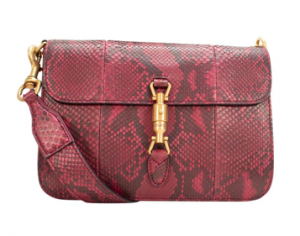 Gucci Burgundy Python Bag with Piston Lock with Gold Brass Hardware. Shop it here.[/caption]
Gucci Burgundy Python Bag with Piston Lock with Gold Brass Hardware. Shop it here.[/caption]
Gucci Padlock:
Not to be confused with the Gucci Lady Lock, the Gucci Padlock was introduced in the Spring/Summer Collection in 2016. The rectangular hardware typically comes in gold, but can also on occasion be seen in silver.
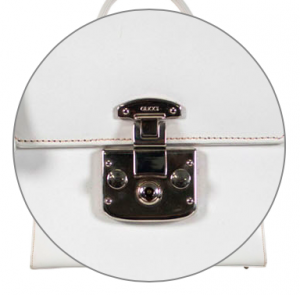
Over the past five years, Gucci Padlock bags have risen to become one of the most popular resale bags by the brand. Gucci Padlock bags are made from a wide variety of materials, but the most popular one is the signature monogram canvas.
[caption id="attachment_14969" align="aligncenter" width="300"] Gucci White Leather Padlock Top Handle Bag with Silver Metal Hardware. Shop it here.[/caption]
Gucci White Leather Padlock Top Handle Bag with Silver Metal Hardware. Shop it here.[/caption]
Gucci Bamboo:
World War II caused a leather shortage in the 1940s, and Guccio Gucci began to turn to alternate materials to construct his bags, eventually choosing to import bamboo from and replace the typical leather handle with a textured bamboo one. This design became extremely popular, so despite the end of the war and rationing, Gucci continued to incorporate bamboo in his designs.
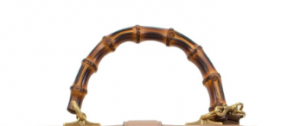
The process of turning ordinary bamboo into Gucci Bamboo is a meticulous one. First, a Gucci craftsman selects the best pieces from each bamboo plant. The bamboo is then softened, and hand processed over an open flame to give it its signature golden-brown colour. Finally, the bamboo is coated with a varnish, to prevent damage. This construction process is carried out completely by hand even to this day, and this handmade procedure ensures that each piece of Gucci Bamboo created is unique.
Frida Giannini helped modernise the Gucci Bamboo, creating a New Bamboo collection in 2010. She utilised new shapes, colours and materials for the bags, and even included shoulder straps to form crossbody bags. Nowadays, Gucci Bamboo can be seen in all mediums, such as timepieces, eyewear, jewellery and perfume!
[caption id="attachment_14967" align="aligncenter" width="300"]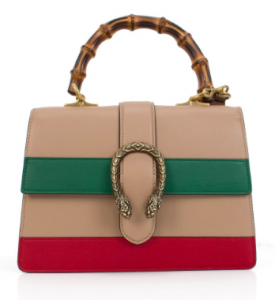 Gucci Dionysus Bamboo Top Handle Flap Bag in Multi-colourway.[/caption]
Gucci Dionysus Bamboo Top Handle Flap Bag in Multi-colourway.[/caption]
(Bag: Sold)
GUCCY:
No, this is not a typo. The “GUCCY” bag debuted in Gucci’s Sping/Summer 2018 Collection, and is a clever reference to Gucci’s dominance in the designer-knockoff market. While other luxury brands hold knockoff products in low regard and view them as piracy and intellectual infringement, Gucci seems to embrace these parody products, even if it’s in a slightly ironic way. The GUCCY logo uses the same font as SEGA (the Japanese entertainment company that specialised in video, arcade, and mobile games), Alessandro Michele using this font to pay homage to the wildly popular video game culture that began in the 1980s.
The tongue-in-cheek nod to knockoff Gucci products that GUCCY provides could also be seen as an homage to Dapper Dan, the “father of logomania”. Dapper Dan was a self-taught pioneer in streetwear in the 1980s, and experimented with redesigning products from luxury brands such as Fendi, Louis Vuitton, and Gucci. Signature Dapper Dan designs involved oversized silhouettes, monograms, and screen-printing. While Dan was forced to shut his original boutique in 1992 due to increasing lawsuits from the brands he took inspiration from, he remained wildly popular and influential in the fashion world, many dubbing him as the original streetwear creator. Gucci and Dapper Dan later collaborated on a menswear line in 2018, after Alessandro Michele referenced a Dapper Dan design without crediting him.
[caption id="attachment_14990" align="aligncenter" width="381"]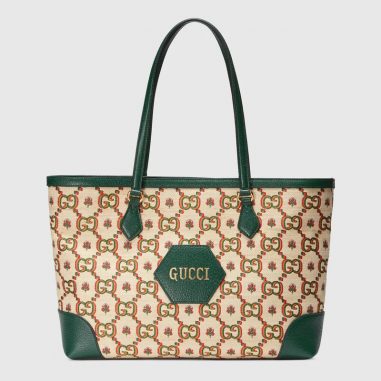 Image: Gucci.com[/caption]
Image: Gucci.com[/caption]
Gucci 100:
In celebration of Gucci’s centennial anniversary, Alessandro Michele created the Gucci 100 collection, which pays an homage to Gucci’s legacy over the past 100 years and creates and interesting blend between the past and the future.
In an interview with ELLE.com, Michele states ““The centennial, for me, represents an opportunity to bear witness to Gucci’s eternal vitality that year after year, is reborn; it renews itself, reestablishing an unusual relationship with contemporaneity as a boy, forever young, observing the world with a powerful vision….I recognized the manifestation of its youth in it having intercepted and traversed, for one hundred years now, popular culture in all its forms. Above all, in music: the only medium, aside from fashion, more reactive to the times that mutate and mark the new, the today, the now.”
As such, the Gucci 100 collection harnesses both music and fashion, creating an extraordinarily whimsical collection that channels youth, energy, and vitality all at once.












